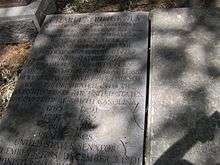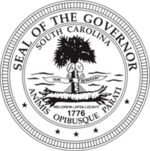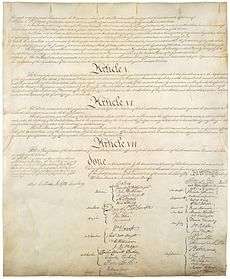Charles Pinckney (governor)
| Charles Pinckney | |
|---|---|
 | |
| 37th Governor of South Carolina | |
|
In office December 9, 1806 – December 10, 1808 | |
| Lieutenant | John Hopkins |
| Preceded by | Paul Hamilton |
| Succeeded by | John Drayton |
|
In office December 8, 1796 – December 18, 1798 | |
| Lieutenant | Robert Anderson |
| Preceded by | Arnoldus Vanderhorst |
| Succeeded by | Edward Rutledge |
|
In office January 26, 1789 – December 5, 1792 | |
| Lieutenant |
Alexander Gillon Isaac Holmes |
| Preceded by | Thomas Pinckney |
| Succeeded by | William Moultrie |
| Member of the U.S. House of Representatives from South Carolina's 1st district | |
|
In office March 4, 1819 – March 4, 1821 | |
| Preceded by | Henry Middleton |
| Succeeded by | Joel Roberts Poinsett |
| United States Minister to Spain | |
|
In office March 1802 – October 25, 1804 | |
| President | Thomas Jefferson |
| Preceded by | David Humphreys |
| Succeeded by | James Bowdoin III |
| United States Senator from South Carolina | |
|
In office December 6, 1798 – June 6, 1801 | |
| Preceded by | John Hunter |
| Succeeded by | Thomas Sumter |
| Delegate from South Carolina to the Congress of the Confederation | |
|
In office November 1, 1784 – October 30, 1787 | |
| 1st President of the South Carolina Senate | |
|
In office August 31, 1779 – January 8, 1782 | |
| Preceded by | Position established |
| Succeeded by | John Lloyd |
| Member of the South Carolina Senate from St. Phillip's and St. Michael's Parish | |
|
In office August 31, 1779 – January 8, 1782 | |
| Member of the South Carolina House of Representatives from St. Phillip's and St. Michael's Parish | |
|
In office November 26, 1810 – November 28, 1814 | |
| Member of the South Carolina House of Representatives from Christ Church Parish | |
|
In office November 24, 1806 – December 9, 1806 | |
|
In office November 26, 1792 – December 8, 1796 | |
|
In office January 1, 1787 – January 21, 1789 | |
| Personal details | |
| Born |
October 26, 1757 Charles Town, South Carolina (now Charleston) |
| Died |
October 29, 1824 (aged 67) Charleston, South Carolina |
| Resting place |
Saint Philip's Episcopal Church Cemetery, Charleston 32°46′45″N 79°55′45″W / 32.7792°N 79.9291°W |
| Political party | Federalist |
| Other political affiliations | Democratic-Republican |
| Spouse(s) | Mary Eleanor Laurens |
| Relations |
Colonel Charles Pinckney (father) Frances Brewton (mother) |
| Children |
Frances Henrietta Pinckney Mary Eleanor Pinckney Henry Laurens Pinckney |
| Residence | "Snee Farm", Mount Pleasant, South Carolina |
| Profession | Lawyer, Statesman |
| Religion | Episcopalian |
Charles Pinckney (October 26, 1757 – October 29, 1824) was an American politician who was a signer of the United States Constitution, the 37th Governor of South Carolina, a Senator and a member of the House of Representatives. He was first cousin once removed of fellow signer Charles Cotesworth Pinckney.
Pinckney was an ancestor of seven future South Carolina governors, a few of which have prominent South Carolinian names, including the Maybank and Rhett families.
Early life and education
Pinckney was born and educated in Charleston, South Carolina. His father, Colonel Charles Pinckney, was a rich lawyer and planter. On his death in 1782, he bequeathed Snee Farm, a plantation outside the city, and his numerous slaves to his eldest son Charles.
Marriage and family
Busy with the war and his political career, Pinckney did not marry until 1787. He married Mary Eleanor Laurens, daughter of Henry Laurens, the wealthy and politically powerful South Carolina merchant and slave trader. They had at least three children.
Among his in-laws were Colonel John Laurens and U.S. Representative David Ramsay; another brother-in-law married the daughter of South Carolina Governor John Rutledge
Career
Pinckney was elected to the Continental Congress (1777–78). He started to practice law in Charleston in 1779 at the age of 21. About that time, well after the War for Independence had begun, young Pinckney enlisted in the militia (though his father demonstrated ambivalence about the Revolution). He became a lieutenant, and served at the siege of Savannah (September–October 1779). When Charleston fell to the British the next year, the young Pinckney was captured and held as a prisoner until June 1781.
He was elected again to the Continental Congress following the war, serving 1784–87. He was elected to the state legislature for several terms (1779–80, 1786–89, and 1792–96). As a nationalist, he worked hard in Congress trying to ensure that the United States would receive navigation rights from Spain to the Mississippi River and to strengthen congressional power.
Pinckney's role in the Constitutional Convention is controversial. Although one of the youngest delegates, he later claimed to have been the most influential one and contended he had submitted a draft, known as the Pinckney Plan, that was the basis of the final Constitution. This was strongly disputed by James Madison and some of the other Framers.[1] He submitted an elaborate form of the Virginia Plan, submitted by Edmund Randolph, but it was disregarded by the other delegates. Historians assess him as an important contributing delegate.[2] Pinckney boasted that he was 24, allowing him to claim distinction as the youngest delegate, but he was 30 years old that year.[3] He attended full-time, spoke often and effectively, and contributed immensely to the final draft and to the resolution of problems that arose during the debates. He also worked for ratification in South Carolina (1788).
At the Convention, Pierce Butler and Pinckney, both from South Carolina, introduced the Fugitive Slave Clause (Article IV, Section II, Clause III). James Wilson of Pennsylvania objected, saying that it was special protection for slaveholders, requiring all state governments to enforce it at taxpayers' expense, in places where no one or most residents did not own slaves. Butler withdrew the clause. But, the next day, a southerner reinstated the clause and the Convention adopted it without further objection. This clause was added to the clause that provided extradition for fugitives from justice.[4]
No Person held to Service or Labour in one State, under the Laws thereof, escaping into another, shall, in Consequence of any Law or Regulation therein, be discharged from such Service or Labour, but shall be delivered up on Claim of the Party to whom such Service or Labour may be due.
This clause was first applied to fugitive slaves and required that they be extradited upon the claims of their masters. This practice was not eliminated until the Thirteenth Amendment abolished slavery. In 1864, during the Civil War, an effort to repeal this clause of the Constitution failed.[5]
He was also responsible for another important clause to the Constitution that later was used, along with the 1st and 14th amendments, to vacate several state constitutions' clauses requiring oaths of office holders to affirm a deity. South Carolina had established Protestantism as the state religion, so it was interesting that he introduced a clause into the Constitution article VI in opposition to an established state religion. His "no religious test" clause read as follows:
no religious test shall ever be required as a qualification to any office or public trust under the United States
Once the inclusion of the phrase was brought to a vote it passed with little opposition and so for the first time in history an official of a national government was not required to have a religion.[6][7] Interesting also was that the final blow to states requiring office holders to swear to God was fought in his home state of South Carolina, that had originally had an established state religion, in the 1997 South Carolina Supreme Court case of Silverman v. Campbell.
Subsequent to his importance and influence as a delegate, Pinckney's political career blossomed. From 1789 to 1792, the state legislature elected him as governor of South Carolina, and in 1790 he chaired the state constitutional convention. During this period, he became associated with the Federalist Party, in which he and his cousin Charles Cotesworth Pinckney were leaders. But, with the passage of time, the former's views began to change.
In 1795 he attacked the Federalist-backed Jay's Treaty. He increasingly began to cast his lot with Carolina back-country Democratic-Republicans against his own eastern aristocracy. The population in the western part of the state was increasing, but apportionment favored the Low Country planters. In 1796 Pinckney was elected governor again by the state legislature. In 1798 his Democratic-Republican supporters in the legislature elected him to the U.S. Senate.
He strongly opposed actions by his former party, and in the presidential election of 1800, served as Thomas Jefferson's campaign manager in South Carolina. The victorious Jefferson appointed Pinckney as Minister to Spain (1801–05). He tried but did not succeed in gaining cession by Spain of the Floridas to the United States. He facilitated Spanish acquiescence in the transfer of Louisiana from France to the United States in 1803 by the Louisiana Purchase.

Pinckney returned from Spain to Charleston and to leadership of the state Democratic-Republican Party. He sat in the legislature in 1805–06 and was again elected as governor (1806–08). In this position, he favored legislative reapportionment, giving better representation to back-country districts, and advocated universal white manhood suffrage. He served again in the legislature from 1810 to 1814, and then temporarily withdrew from politics. In 1818 he won election to the United States House of Representatives, where he fought against the Missouri Compromise as he was interested in having slavery be expanded to new territories and states.
In 1821, with his health beginning to fail, Pinckney retired for the last time from politics. He died in 1824, three days after his 67th birthday. He was laid to rest at St. Philip's Episcopal Churchyard in Charleston.[8]
Legacy and honors
- Pinckney's Snee Farm plantation is maintained as Charles Pinckney National Historic Site.
- His son, Henry L. Pinckney (September 24, 1794 – February 3, 1863) was a U.S. Representative from South Carolina, and mayor of Charleston. His daughter married Robert Young Hayne, U.S. Representative, mayor of Charleston, and governor of South Carolina.
See also
- U.S. Constitution, slavery debate in Convention
References
- United States. National Park Service. (1976), Signers of the Constitution: historic places commemorating the signing of the Constitution (The National survey of historic sites and buildings, v. 19), retrieved 2007-11-03
- Marty D. Mathews, Forgotten Founder: The Life and Times of Charles Pinckney (Columbia: University of South Carolina Press, 2004).
- ↑ James Madison on the Pinckney Plan, Farrand's Records of the Federal Convention, http://oll.libertyfund.org/titles/farrand-the-records-of-the-federal-convention-of-1787-vol-3#lf0544-03_head_424.
- ↑ MacDonald Forrest,E Pluribus Anum: The Formation of the American Republic 1776–1790(Houghton Mifflin Company:Library of Congress Catalog Card: 65-111322) 1965 pp. 166–167.
- ↑ Yates Publishing. U.S. and International Marriage Records, 1560–1900 [database on-line]. Provo, UT, US: The Generations Network, Inc., 2004.
- ↑ Paul Finkelman, Slavery and the Founders: Race and Liberty in the Age of Jefferson, p. 82, 2nd Edition, 2001.
- ↑ The vote in the House was 69 for repeal and 38 against, which was short of the two-to-one vote required to amend the Constitution. See the Congressional Globe, 38th Cong., 1st Sess., 1325 (1864)
- ↑ Drawn from original source: Charles C. Haynes (1991). "overview: history of religious liberty in America". A Framework for Civic Education. Council for the Advancement of Citizenship and the Center for Civic Education.
- ↑ Drawn from original source: "The Individual Liberties within the Body of the Constitution: A Symposium: The No Religious Test Clause and the Constitution of Religious Liberty: A Machine That Has Gone of Itself." Case Western Reserve Law Review 37: 674–747. Dreisbach, Daniel L. 1999. "The Bill of Rights: Almost an Afterthought?". ABC-CLIO. 2011.
- ↑ Charles Pinckney at Find a Grave
External links
- United States Congress. "Charles Pinckney (id: P000354)". Biographical Directory of the United States Congress.
- SCIway Biography of Charles Pinckney
- NGA Biography of Charles Pinckney
- The Plan of Charles Pinckney – Submitted as an alternative to the Virginia Plan
| Political offices | ||
|---|---|---|
| Preceded by Thomas Pinckney |
Governor of South Carolina 1789–1792 |
Succeeded by William Moultrie |
| Preceded by Arnoldus Vanderhorst |
Governor of South Carolina 1796–1798 |
Succeeded by Edward Rutledge |
| Preceded by Paul Hamilton |
Governor of South Carolina 1806–1808 |
Succeeded by John Drayton |
| United States Senate | ||
| Preceded by John Hunter |
U.S. Senator (Class 2) from South Carolina 1798–1801 Served alongside: Jacob Read, John Ewing Colhoun |
Succeeded by Thomas Sumter |
| Diplomatic posts | ||
| Preceded by David Humphreys |
U.S. Minister to Spain 1802–1804 |
Succeeded by George W. Erving |
| United States House of Representatives | ||
| Preceded by Henry Middleton |
Member of the U.S. House of Representatives from South Carolina's 1st congressional district 1819–1821 |
Succeeded by Joel R. Poinsett |


